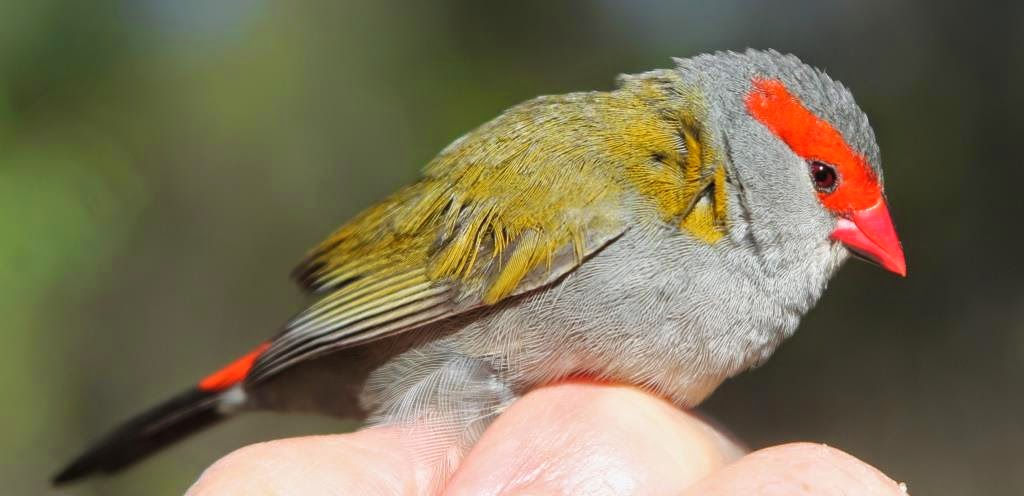Banding was carried out at the reserve and private property adjacent to the Coutts Crossing Cemetery on Saturday May 24 and Sunday May 25. Thirty birds of 15 species were mist netted over the two days. There were two retraps.
 |
| Red-bellied Black Snake |
Banders: Greg Clancy, Jan Patterson, Bill Greenlees
Assistants/Visitors: Warren Thompson, Val Clancy
The results are
shown in the table below.
SPECIES
|
24/05/2014
|
25/05/2014
|
TOTALS
|
Banded
Retrapped
|
Banded
Retrapped
|
Banded
Retrap
|
|
Peaceful
Dove
|
1 0
|
0 1
|
1 1
|
Grey
Fantail
|
2 0
|
3 0
|
5
0
|
Willie
Wagtail
|
0 0
|
1 0
|
1 0
|
Eastern
Yellow Robin
|
1 0
|
2 0
|
3 0
|
Golden
Whistler
|
1 1
|
1 0
|
2 1
|
Speckled
Warbler
|
0 0
|
2 0
|
2 0
|
Red-backed
Fairy-wren
|
0 0
|
1 0
|
1 0
|
Eastern
Spinebill
|
1 0
|
2 0
|
3 0
|
Brown
Honeyeater
|
1 0
|
0 0
|
1 0
|
Lewin’s
Honeyeater
|
0 0
|
1 0
|
1 0
|
Fuscous
Honeyeater
|
0 0
|
1 0
|
1 0
|
Yellow-faced
Honeyeater
|
2 0
|
2
0
|
4 0
|
Blue-faced
Honeyeater
|
0 0
|
1 0
|
1 0
|
Red-browed
Finch
|
0 0
|
1 0
|
1 0
|
Pied
Butcherbird
|
1 0
|
0 0
|
1 0
|
TOTALS
|
10 1
|
18 1
|
28 2
|
 |
| Peaceful Dove showing underwing colour |
One of the Golden
Whistlers had a tail/wing ratio suggested that it was from Tasmania. The other two had ratios that were in the
overlap zone of measurements, meaning that they could have been Tasmanian birds
or may have been mainland birds. One was
an adult male and its upper tail colouration suggested that it was a Victorian
or southern New South Wales bird.
 |
| Adult male Golden Whistler |
 |
| Tail of adult male Golden Whistler showing olive base |
The two
Speckled Warblers were of interest as this species is listed as threatened in
New South Wales and is a declining woodland species. It is rare in the Clarence Valley but the
Coutts Crossing banding site is a regular location. There have only been 9 other Speckled
Warblers banded at the site since 1987.
 |
| Adult female Speckled Warbler (rufous eyebrow) |
Based on
their tail/wing ratios the 5 Grey Fantails would appear to be Tasmanian
birds. The one Fuscous Honeyeater is the
first banded at the site since 1990 and there have only been 12 others banded
at the site since 1986.
 |
| Adult female Fuscous Honeyeater |
.
Interesting
observations were of Little and Musk Lorikeets, 1+ Weebill and a flock of
approximately 12 White-winged Choughs. A dark wallaby only glimpsed was almost
certainly a Swamp Wallaby and scats found near of one the nets matched that
species. This is the first record of the
species at this site. I have only seen
one other near Coutts Crossing. It was
at the Orara River banding site a few years back. Red-necked Wallabies, Eastern Grey Kangaroos
and Rufous Bettongs are the usual macropods found at the Coutts Crossing site
near the Cemetery.
I had a close
encounter with an adult Red-bellied Black Snake. I reached down to pull out a couple of pine
wildlings and as I reached for one I sensed something very close. I had put my hand next to the head of the
snake. It became very defensive and
raised its head preparing to strike if necessary. I managed a few photos and then left it to
make its escape unhindered.
I
photographed an interesting grass, the Silky Browntop Eulalia aurea, that isn’t listed for
the NSW North Coast in the Flora of NSW.
It is known from the Northern Tablelands.
 |
| Silky Browntop |
 |
| Silky Browntop |
 |
| Immature Pied Butcherbird |
 |
| Immature Pied Butcherbird |
 |
| First year Eastern Yellow Robin |
 |
| Yellow-faced Honeyeater |
 |
| Adult Willie Wagtail |
 |
| Adult Willie Wagtail |
 |
| Adult male Red-browed Finch |
 |
| Adult female Eastern Spinebill |
 |
| Adult female Blue-faced Honeyeater |
As usual we had a productive couple of days of banding and handled some beautiful birds. We are very fortunate on the New South Wales North Coast to have such a great diversity of birds.




No comments:
Post a Comment